 | IN DISCUSSION
| IN DISCUSSION
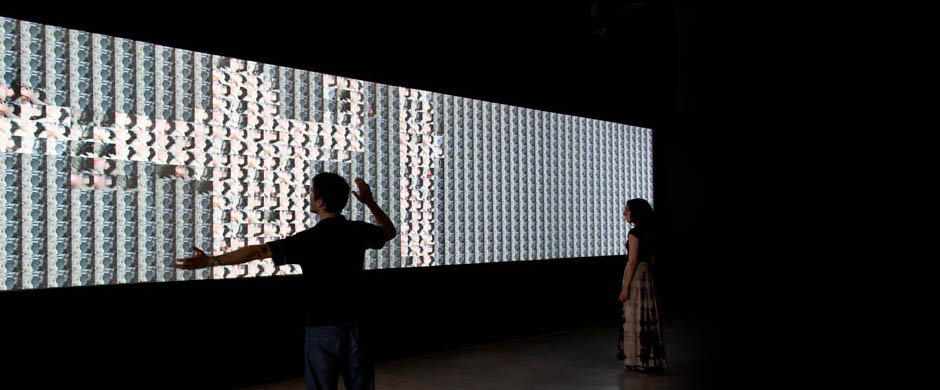
Rafael Lozano-Hemmer, Make Out, Shadow Box 8, 2008
Topics in Time-based Media Art Conservation
The Conservation Center’s Topics in Time-Based Media Art Conservation lecture series is generously supported by the the Mellon Foundation. The series is organized by Christine Frohnert. Learn more about our Time-Based Media art conservation curriculum.
A video of each lecture is archived and available after the event in the Institute's video archive.
Recent Events
February 28, 2025
Speakers: J. Cabelle Ahn, Nicholas Eastaugh, Carol Mancusi-Ungaro, David G. Stork
Title: The Machine Gaze: AI in Art Conservation and Analysis
The rapid development of artificial intelligence tools is profoundly transforming cultural production and our approaches to preserving humanity’s shared past. Machine learning and computational techniques have already begun to assist conservators, scientists, and scholars in decoding complex datasets, revealing hidden features in artworks, restoring lost elements, and forging new connections between historical art and modern artistic practices. AI has even been used to consider an artwork’s authenticity through image analysis.
Yet, these advances also raise pressing ethical and philosophical questions about the implications of this new machine gaze—AI’s ability to observe, analyze, and interpret. How can we trust that AI processes information and presents conclusions accurately? What safeguards are needed to mitigate biases inherent in training datasets and algorithms? And to what extent should AI be considered a reliable collaborator in art-related decision-making processes?
This roundtable brings together experts in computer science, conservation, and art history to examine the application of AI in cultural heritage conservation and art analysis, exploring both the successes and limitations of these technologies. The discussion will further consider the future of AI in this field, emphasizing the necessity of interdisciplinary collaboration to ensure these technologies responsibly shape the cultural landscape of tomorrow.
Panelists:
J. Cabelle Ahn is a New York-based art historian, journalist, and non-profit director. She received her PhD in History of Art from Harvard University, where she conducted a data-driven analysis of early exhibition strategies and the corresponding changes in the secondary art market. She holds MA degrees from the Courtauld Institute of Art and Bard Graduate Center and has held fellowships at the Harvard Art Museums, The Morgan Museum and Library, and the Cooper Hewitt, among others. She presently specializes in connecting historical art and its markets to their contemporary counterparts. Her bylines can be found at the Art Newspaper, Artnet News, Master Drawings, Journal18, and in several edited volumes and periodicals. She is currently working on a series of articles that looks at how contemporary artists are rescripting Old Masters through the lens of artificial intelligence (AI) and machine learning. She is currently the President of the Association of Print Scholars, where she has been an officer since 2019.
Nicholas Eastaugh is a leading scientific art expert. He is recognized as a global authority for art forensic analysis that combines scientific precision and cutting-edge technology with art historical scholarship for the analysis, attribution, authentication, and appreciation of artwork. He is currently the CEO of Vasarik Ltd, a new company focused on developing novel approaches using AI and machine learning to solve problems around attribution of art and risk in the art market. Dr. Eastaugh has appeared regularly on programs such as the BBC's Britain's Lost Masterpieces as an expert art scientific advisor. He co-founded the Pigmentum Project and published The Pigment Compendium, which quickly became a standard reference text in the field. Previously, Dr. Eastaugh was the Founder and Chief Scientist of Art Analysis & Research, and a Visiting Research Fellow at the University of Oxford. He originally trained as a physicist before going on to complete a PhD in scientific analysis and documentary research of historical pigments at the Courtauld Institute of Art, London.
Carol Mancusi-Ungaro served as the Melva Bucksbaum Associate Director for Conservation and Research at the Whitney Museum of American Art and was the Founding Director of the Center for the Technical Study of Modern Art at the Harvard Art Museums. As Chief Conservator of The Menil Collection, she founded the Artists Documentation Program (adp.menil.org) in 1990. In 2009 she was elected a Fellow of the American Academy of Arts and Sciences, marking the Academy’s first recognition of art conservation, and in January 2016 her work was featured in a New Yorker profile entitled “The Custodians.” In 2016 she was awarded the Forbes Prize by the International Institute for Conservation of Historic and Artistic Works and in 2021-2022 she was awarded the Rome Prize by the American Academy in Rome. She continues to engage in research and writing about issues pertaining to the conservation of modern art.
David G. Stork is an Adjunct Professor in two departments and two programs at Stanford University and widely considered the founding pioneer of the application of sophisticated computer vision and artificial intelligence to problems in the history and interpretation of fine-art paintings and drawings. He published the earliest technical scholarship in the field, taught its first courses (at Stanford), co-founded its first conference (now called Computer Vision and Analysis of Art), and published its first book, Pixels & paintings: Foundations of computer-assisted connoisseurship (Wiley, 2024). He has lectured at dozens of leading museums worldwide and taught computer methods at the Courtauld Institute of Art in London. He has published over 220 scholarly works and 64 issued patents and is a Fellow of eight international professional/scholarly organizations and a 2023 Leonardo@Djerassi Fellow. He is completing his tenth book, Principled art authentication: A probabilistic foundation for representing and reasoning under uncertainty.
Moderated by:
Lisa Conte is Assistant Professor of Paper Conservation and Co-Chair of the Conservation Center of the Institute of Fine Arts at New York University.
January 29, 2025
Speaker: Christiane Paul, Whitney Museum of American Art
Title: AI Art Histories: From Concepts to Conservation
Over its more than fifty year-long history, AI art has evolved along with technological approaches, from the early symbolic phase to the current statistical one of artificial neural networks. The talk traces the historical trajectory of AI art, connecting the underlying technologies to concepts, aesthetics, and conservation challenges. Expert systems, generative adversarial networks (GANs), generative pre-trained transformers (GPTs), and text-to-image models are tied to different creative practices and expressions, which in turn require specific methods of preservation. Recent AI technologies rely on classification, standardization, and optimization, using trillions of existing images harvested by corporations and operating within an echo chamber. Through the lens of artistic practice, the talk explores AI image production and its relationship to data models and materialities.
Christiane Paul is Curator of Digital Art at the Whitney Museum of American Art and Professor Emerita at The New School. She is the recipient of 2023 MediaArtHistories International Award and the Thoma Foundation 2016 Arts Writing Award in Digital Art. Her books are Digital Art (4th ed., 2023); A Companion to Digital Art (Blackwell-Wiley, 2016); Context Providers – Conditions of Meaning in Media Arts (Intellect, 2011; Chinese edition, 2012); and New Media in the White Cube and Beyond (UC Press, 2008). At the Whitney Museum she curated exhibitions including Harold Cohen: AARON (2024), Refigured (2023), and Programmed: Rules, Codes, and Choreographies in Art 1965 - 2018 (2018/19) and is responsible for artport , the museum’s portal to Internet art. Other curatorial work includes Chain Reaction (feralfile.com, 2023), DiMoDA 4.0 Dis/Location (traveling show, 2021-2023), and The Question of Intelligence (Kellen Gallery, The New School, NYC, 2020).
The Conservation Center’s Topics in Time-Based Media Art Conservation lecture series is generously supported by the Mellon Foundation. The series is organized by Christine Frohnert. A video of each lecture is archived and available after the event in the Institute's video archive.
June 3, 2024
Speaker: Refik Anadol
Title: Creating AI Art with a Thinking Brush
Based in Los Angeles, Refik Anadol Studio conducts interdisciplinary research on the relation between the human mind, data aesthetics, machine learning technologies, and nature. Coining the terms “AI Data Painting,” “AI Data Sculpture,” and “latent city,” Anadol has been reflecting on new multi-sensory forms of narrating collective memory in physical and virtual spaces and inviting his audience to imagine Generative Realities. In this talk, Anadol will share the research and production journeys of his Studio's internationally renowned artworks, which collectively offer a dramatic rethinking of our many environments. The artist will also shed light on his most recent interdisciplinary collaborations with various scientists and communities around the world to build a bridge between nature-themed data and generative art.
Refik Anadol (b. 1985, Istanbul, Turkey) is an internationally renowned media artist, director, and pioneer in the aesthetics of data and machine intelligence. He is the Director of Refik Anadol Studio in Los Angeles and Lecturer in UCLA’s Department of Design Media Arts. Anadol’s work locates creativity at the intersection of humans and machines. Taking the data that surrounds us as primary material, and the neural network of a computerized mind as a collaborator, Anadol offers us radical visualizations of our digitized memories and expands the possibilities of interdisciplinary arts. Anadol’s site-specific data paintings and sculptures, live audio/visual performances, and immersive installations take many forms, while encouraging us to rethink our engagement with the physical world, collective experiences, public art, decentralized networks, and the creative potential of AI. Anadol’s work has been exhibited at venues including MoMA, Centre Pompidou-Metz, Art Basel, National Gallery of Victoria, Venice Architecture Biennale, Hammer Museum, Arken Museum, Dongdaemun Design Plaza, Ars Electronica, Istanbul Modern, and ZKM | Center for Art and New Media. Anadol has received a number of awards and prizes including the Lorenzo il Magnifico Lifetime Achievement Award for New Media Art, Microsoft Research’s Best Vision Award, German Design Award, UCLA Art+Architecture Moss Award, Columbia University’s Breakthrough in Storytelling Award, and Google’s Artists and Machine Intelligence Artist Residency Award.
April 17, 2024
Speaker: Dr. Brian Castriota
Title: Tuning In: Attunement as an Embodied Methodology for Conservation Practices
In conservation theory and practice considerable attention (and anxiety) has been directed towards strictly delimited notions of authenticity in the context of contemporary artworks and the ways conservators intervene in their materialization(s). This talk considers how a methodology of attunement—figured in the context of conservation—helps bring attention to the ethics, politics, and principles inscribed within a work of art that might otherwise go un-sensed or be disregarded, as well as the varied ways in which conservation practices might attend to and promote them. Attunement is positioned as an individual and collective responsiveness (or Baradian “response-ability”) to that which we seek to provide care, where sedimented practices of musealization and habituated modes of thinking and doing conservation—often driven by colonialist and capitalist logics—are able to be generatively (re-)worked. In so doing, this talk considers how tuning into and becoming attuned to a work’s specificities aligns with an expanded notion of care.
Dr. Brian Castriota is Lecturer in Conservation of Contemporary Art and Media at University College London, Time-Based Media Conservator at the National Galleries Scotland, and Freelance Conservator for Time-Based Media and Contemporary Art at the Irish Museum of Modern Art. He completed graduate-level training in conservation at the Institute of Fine Arts, New York University in 2014, and earned a Ph.D. in History of Art from the University of Glasgow in 2019 as part of the Marie Skłowdoska-Curie ITN New Approaches in the Conservation of Contemporary Art (NACCA). His research and publications largely focus on how ideas from poststructuralism, queer theory, agential realism, and postqualitative inquiry rework sedimented theories and practices of conservation, particularly in relation to contemporary artworks, their musealization, and their documentation for conservation purposes.
May 12, 2023
Book Launch for the Conservation of Time-Based Media Art
In-Person and Virtual Lecture
This hybrid event celebrates the publication of Conservation of Time-Based Media Art, the first book to take stock of the current practices and conceptual frameworks that define the emerging field of time-based media conservation. The editors Deena Engel and Joanna Phillips are joined by chapter authors to discuss the communal process of putting practice to paper.
The book was written and compiled by a diverse group of time-based media practitioners around the world, including conservators, curators, registrars, and technicians. Designed as a handbook, it offers a comprehensive survey of specialized practices that have developed around the collection, preservation, and display of time-based media art. Divided into 23 chapters with contributions from 36 authors and 85 additional voices, the narrative of this book provides both an overview and detailed guidance on critical topics, including the acquisition, examination, documentation, and installation of time-based media art.
Conservation of Time-Based Media Art serves as a critical resource for conservation students and for a diverse professional audience who engage with time-based media art, including conservation practitioners and other collection caretakers, curators, art historians, collectors, gallerists, artists, scholars, and academics.
There will be presentations and panels by the editors and chapter authors from 3PM to 5PM EDT, followed by an in-person reception at the Institute of Fine Arts from 5PM to 7PM EDT.
3:00 PM
Welcome
Speakers: Michele Marincola and Christine Frohnert
3:15 PM
Putting Practice to Paper: The Conservation of Time-based Media Art.
Speakers: Deena Engel and Joanna Phillips
3:35 PM
Chapter Stories: The Making-of a Time-based Media Handbook
Speakers: Kate Lewis, Jonathan Farbowitz, Chris McDonald, John Klacsmann, Jeffrey Warda
4:05 PM
Forging a Professional TBM Community
Moderator: Christine Frohnert
Zoom Panelists: Alex Nichols, Patricia Falcão, Eddy Colloton, Hélia Marçal
4:45 PM
Wrap-up
Speakers: Deena Engel and Joanna Phillips
5:00 PM
In-person Reception at the Duke House, the Institute of Fine Arts, NYU
7:00 PM End of Event
Book Launch Program Bios
Deena Engel, Clinical Professor Emerita of the Department of Computer Science at the Courant Institute of Mathematical Sciences at New York University, focuses her research on contemporary art. The winner of four teaching awards, she has experience teaching undergraduate computer science courses on web and database technologies, as well as Digital Humanities courses for graduate students. Deena is the Co-Director along with Prof. Glenn Wharton of the Artist Archives Initiative, and she also works with major museums on projects which address the challenges involved in the conservation of time-based media art. She has an MA in Comparative Literature and Literary Translation from SUNY-Binghamton and an MS in Computer Science from the Courant Institute of Mathematical Sciences. She is currently pursuing a PhD at the Bard Graduate Center in New York City.
Joanna Phillips is a time-based media conservator and Director of the Düsseldorf Conservation Center in Germany. She was previously Senior Conservator of Time-Based Media at the Solomon R. Guggenheim Museum in New York (2008–19), where she launched the first media conservation lab in a US museum, implemented time-based media conservation practices, and headed the Conserving Computer-Based Art (CCBA) initiative. She co-founded the AIC conference series TechFocus and lectures and publishes on TBM topics internationally. As a researcher in the Swiss project AktiveArchive, she co-authored the Compendium of Image Errors in Analog Video (2013). Phillips earned her MA in Paintings Conservation from the Dresden University of Fine Arts, Germany (2002).
Participants in the panels
Eddy Colloton is Project Conservator of Time-Based Media for the Hirshhorn Museum and Sculpture Garden, where he works closely with the conservation department on the museum’s diverse array of media artworks. Colloton received his MA degree from the Moving Image Archiving and Preservation program at New York University in May 2016. Colloton has previously worked as Assistant Conservator at the Denver Art Museum and Time-Based Media Technician at the Los Angeles County Museum of Art.
Patricia Falcão is a Portuguese time-based media conservator working at Tate, where she researches and develops strategies for the preservation of software-based artworks and digital objects. More recently, in the context of the Reshaping the Collectible project, this has broadened to include the acquisition and preservation of web-based artworks. Patricia is also a collaborative doctoral researcher at Tate and Goldsmiths (University of London, UK) investigating preservation practices for software-based art in three different contexts: contemporary art museums, working with artists and in the gaming industry.
Jonathan Farbowitz is the Associate Conservator of Time-Based Media at The Metropolitan Museum of Art. Previously, Jonathan was a Fellow in the Conservation of Computer-Based Art at the Solomon R. Guggenheim Museum, where he took part in the restoration process for the museum’s three web artworks. He holds an M.A. in Moving Image Archiving and Preservation from New York University and a B.A. in Film from Vassar College and has previous experience in software development and testing.
John Klacsmann is Archivist at Anthology Film Archives in New York City, where he preserves artists’ cinema and experimental film. Klacsmann holds a bachelor of science in Computer Science from Washington University in St. Louis and is a graduate of the George Eastman Museum’s L. Jeffrey Selznick School of Film Preservation. Before joining Anthology in 2012, he worked as a preservation specialist and optical printing technician at Colorlab, a film laboratory in Maryland. He co-edited two volumes of The Collections of Harry Smith: Catalogue Raisonné and Manuel DeLanda: ISM ISM. He is a contributing editor of INCITE: Journal of Experimental Media.
Kate Lewis is a media conservator and Agnes Gund Chief Conservator at the Museum of Modern Art, New York. She has worked with artists including Beryl Korot, David Lamelas, Tony Oursler, and Lis Rhodes. Prior to joining MoMA, she held the position of Time-Based Media Conservator at Tate in London (2005–13). She earned her MA in the Conservation of Works of Art on Paper from the University of Northumbria at Newcastle-upon-Tyne, UK. Engaged in training and education, Lewis led the five-year Media Conservation Initiative at MoMA, funded by The Andrew W. Mellon Foundation, to address the long-term preservation of media-based works through professional collaborative training and serves on the board of Voices in Contemporary Art (VoCA).
Hélia Marçal is Lecturer (Assistant Professor) in History of Art, Materials, and Technology at the Department of History of Art, University College London, and a researcher at the Institute of Contemporary History (NOVA University of Lisbon). Before this appointment, she was the Fellow in Contemporary Art Conservation and Research of the research project Reshaping the Collectible: When Artworks Live in the Museum, at Tate, London (2018–20). In addition, she has been the coordinator of the Working Group on Theory, History, and Ethics of Conservation of the Committee for Conservation of the International Council of Museums (ICOM- CC) since 2016.
Christopher McDonald is an artist and sound engineer who lives in Connecticut. His most recent exhibition at SPACE Gallery in Portland, Maine, featured video works, photographs, pastels, and egg tempera paintings from the last decade. When he is not blazing new trails in the woods with his goats, he has collaborated as Ragnar Kjartansson’s director of sound on works such as The Visitors (2013) and Sumarnótt (2019). He has supervised the installation of these works at the Hirshhorn Museum, The Metropolitan Museum, and the GES-2 in Moscow. Homesteading with his husband remains the constant and renewing highlight of his life.
Alexandra Nichols is Time-Based Media Conservator at Tate, focusing on exhibitions and displays. Prior to working at Tate, she was a Sherman Fairchild Foundation Fellow at The Metropolitan Museum of Art and a Samuel H. Kress Fellow at the Solomon R. Guggenheim Museum in New York, concentrating on the conservation of time-based media. Alexandra Nichols holds an MS in Art Conservation from the Winterthur/University of Delaware program in Art Conservation and a BA in Art History from the University of Maryland.
Jeffrey Warda is Senior Conservator, Paper and Photographs at the Solomon R. Guggenheim Museum, New York. He has worked closely with artists, photography labs, and technicians to complete multiple digitization, slide duplication, and rehousing projects of slide-based artworks for acquisition and display. He was chair of both the Electronic Media Group (2006–08) and the Digital Photographic Documentation Task Force (2007–08) of the American Institute for Conservation (AIC). He co-authored and edited both editions of The AIC Guide to Digital Photography and Conservation Documentation (2008 and 2011), a publication that provided practical recommendations for conservators transitioning from film-based conservation documentation to digital photography. He also founded and was managing editor (2009–2014) of the AIC Electronic Media Group’s biennial publication, the Electronic Media Review—the first print publication of EMG designed to build a body of knowledge for the field of time-based media conservation. He received an MA and Certificate of Advanced Study in art conservation from the State University of New York College at Buffalo.
November 30, 2022
Speaker: Tom Ensom
Title: A Medium for Building Worlds: Conserving Artworks Created in Game Engines
Description: Game engines are software tools for building virtual environments and experiences. They simulate properties of the real world, like materials and physics, while supporting the creation of different realities with their own geographies and rules. Having emerged in the context of video game development, game engines are also finding use in the creation of software-based art. When displayed, these artworks consist of moving image sequences that play out in real-time, allowing them to respond dynamically to input or unfold in unpredictable ways. This talk will consider the theoretical and technical considerations involved in the conservation of artworks made in game engines, and reflect on the role of the conservator when working with an emerging medium.
Tom Ensom (he/him) is a freelance digital conservator specialising in the conservation of software-based art. In 2018 he completed his PhD, which explored approaches to the documentation of software-based art through a collaborative doctoral partnership between King’s College London and Tate. He continues to work closely with Tate’s Time-based Media Conservation team, where he has helped develop their conservation strategy for software-based art and works on the acquisition of a wide range of time-based media artworks. His current research focus is the conservation of artworks which employ real-time 3D rendering and immersive media technologies.
June 30, 2022 and
July 1, 2022
Reflections and Projections: Time-based Media Art Conservation Education and Outreach
Time-based Media (TBM) artworks are characterized by having a durational element, such as sound, performance, light, or movement, which unfolds to the viewer over time via slide, film, video, software, or the internet. Preserving them presents particular challenges, given their conceptual nature and use of components that extend well beyond traditional categories of art materials.
For further information, please visit www.tbmatnyu2022.com
In order to meet the ever-increasing complexities of TBM art conservation, the next generation of media conservators must cross over the disciplinary boundaries of computer science, material science, media technology, engineering, art history, and conservation.
Thanks to generous funding from the Mellon Foundation, the Conservation Center of the Institute of Fine Arts at New York University has designed and implemented the Time-based Media (TBM) Art Conservation Education and Training Program, the first of its kind in the US.
This webinar will present teaching concepts developed by instructors, as well as student perspectives over four years of curriculum implementation. Educators and professionals from other programs are invited to discuss their teaching approaches in the classroom and beyond. Resources developed at the Conservation Center will be shared to promote TBM art conservation education and training and to inspire others embarking on similar initiatives.
Organizers and moderators: Dr. Hannelore Roemich, Hagop Kevorkian Professor of Conservation, and Christine Frohnert, Research Scholar and TBM Program Coordinator, at the Conservation Center, Institute of Fine Arts, New York University. Contact for further information: hr34@nyu.edu.
Wednesday, July 27, 2022
Speaker: Lino García Morales
Title: New Media Art Conservation: A theoretical approach to permanence through change
Description: New media are fragile. Their Achilles heel is technological obsolescence and the technical fragility production process itself. This theoretical approach to permanence through change offers an alternative to other conservation-restoration theories based on two fundamental paradigms: antifragility and evolvability. While traditional conservation theories consider new media art as art ("more of the same"), this approach starts from a logical typification free of paradoxes. This presentation explores the philosophical underpinnings of this theory, a methodology of production-recreation of new media artworks that ensures the preservation of the work's identity over time.
Lino García Morales is a musician, writer, teacher and conservator of new media. He completed an engineering degree in automatic control at the ISPJAE, a master's degree in Systems, Signals and Communications at the Universidad Politécnica de Madrid (UPM), a Ph.D. in Telecommunications at the UPM and a Ph.D. in Conservation and Restoration of New Media at the Universidad Europea de Madrid (UEM). He has designed and coordinated Masters in Conservation-Restoration of Contemporary Art for the Universidad Complutense de Madrid (UCM) and the Museo Nacional Centro de Arte Reina Sofía (MNCARS), Cultural Heritage Management (UCM-UPM), Forensic Acoustics (UPM), Degree in Digital Art (UEM), Degree in Digital Design (Universidad Internacional de La Rioja). He has produced new media works for artists such as Hans Haacke and coordinated the development of a program for the conservation study of Guernica at MNCARS.
The lecture will be presented in Spanish with English subtitles. The event will be moderated in both Spanish and English by Caroline Gil, Director of Media Collection and Preservation at Electronic Arts Intermix, New York.
Leer en español.March 2, 2022
Speaker: Asti Sherring
Title: Changeability, Variability, and Malleability: Applying Time-based Media Conservation Principles to the Preservation of “Big Stuff”
Description: The key issues for all communities caring for changeable objects are how to preserve the intangible sensory, cultural, and immersive experiences created by change over time. While traditional conservation tenets seek to arrest change by preserving the tangible components of an object with minimal physical change, Time-based Media conservation theories advocate for long-term activation of changeable objects that preserve the intangible, embodied experience. This presentation is based on a collaborative research project with Utilitarian heritage conservator Alison Wain and explores how best practice in the conservation of changeable objects must acknowledge and manage the tension between these conflicting ideas to ensure that object authenticity can evolve as time and contexts change. By viewing objects through the lens of change, we can open the door to the development of a new field of conservation expertise.
Asti Sherring is a paper, photographs and time-based media conservator. She has completed a Bachelor of Media Arts (honours) from Sydney University and a Masters of Materials Conservation at Melbourne University. Asti held the position of senior time-based art conservator at The Art Gallery of New South Wales between 2015-2020. She has also worked at institutions such as Los Angeles County Museum of Art and Museum of Contemporary Art, Sydney. Asti is currently working in private practice and undertaking doctorate research at Canberra University, which explores contemporary conservation theories and practices of works that are digital, ephemeral, immersive, participatory and technological in nature.
December 1, 2021
Speakers: Carl D. Thoma, Kate Weinstein and Jason Foumberg
Title: Perspectives from a Private Collection: How the Thoma Foundation Collects and Conserves Digital, Video and Media Art
Description: The Carl & Marilynn Thoma Foundation, founded in 2014, confronts conservation and display challenges by actively performing solutions on its growing collection of 336 artworks by 176 artists in Digital, Video and Media Art. This talk brings together the Foundation’s collection care team and founder to share insights on how they collaborate with each other, artists, and other experts. Collector Carl Thoma discusses why certain artworks draw his attention, and how he is supporting programs that serve to strengthen the sustainability and appreciation of art and technology. Curator Jason Foumberg reviews the Foundation’s thematic approach to exhibitions, and the direction of its acquisition program. Collections Manager Kate Weinstein explores technical, preparatory and conservation issues across the Foundation’s spectrum of vintage and emerging technologies. Thomafoundation.org
Carl D. Thoma is an art collector, philanthropist, and managing partner and founder of Thoma Bravo, LLC. An early player in the field of venture capital beginning with Golder, Thoma in 1980, Carl has applied his eye for entrepreneurial talent to collecting Modern and Contemporary paintings, and most recently in the fields of Digital Art and Light & Space.
In his chosen profession, Carl has been acknowledged in The Wall Street Journal, Business Week, and Fortune for his investment leadership. He has chaired the National Venture Capital Association and the Illinois Venture Capital Association, and served on the boards of Illinois Institute of Technology and Stanford Graduate School of Business Advisory Council. He is currently on the Boards of the McKnight Center for the Performing Arts, the Terra Foundation for American Art, and SITE Santa Fe; is a member of the Blanton National Leadership Board; and is a commissioner for the National Portrait Gallery. Carl Thoma earned his bachelor’s degree from Oklahoma State University and his MBA from Stanford’s Graduate School of Business.
Kate Weinstein is the Collections Manager & Registrar at the Thoma Foundation, and is based in Chicago, IL. Kate oversees the collection care for the Foundation’s five collection areas, including the Digital & Media Art collection. Along with this, Kate oversees the Foundation’s policies and procedures for conservation, storage, shipping, loans, and acquisitions. She received her MA in Modern Art History, Theory + Criticism from the School of the Art Institute of Chicago (2012) where she wrote her thesis on animated GIFs.
Jason Foumberg is the Thoma Foundation Curator of Digital & Media Art. Since 2014, he has curated annual exhibitions at the Foundation’s public spaces in Santa Fe and Chicago, as well as touring exhibits of digital art with U.S. museum partners. Jason advises on the Foundation’s art collection and grant programs. He is based in Chicago, Illinois.
November 3, 2021
Speakers: Erica Papernik-Shimizu, Amy Brost, Lia Kramer, Andy Wolf and Jochen Saueracker
Title: Video Sculpture in Shigeko Kubota: Liquid Reality at MoMA: Collaboration, Conservation, and Care
Description: The exhibition Shigeko Kubota: Liquid Reality features a selection of groundbreaking video sculptures made between 1976-85, presented together for the first time in thirty years. Positioned by the artist between “reality and mirage,” the conservation and care of these multilayered works pose a compelling set of concerns, activating questions that typically pertain to disparate classifications of art: unique sculptural objects, variable media, and conceptual propositions. In this virtual roundtable, Erica Papernik-Shimizu, Associate Curator, Department of Media and Performance at MoMA will be joined by conservators Amy Brost, Lia Kramer, and Andy Wolf to discuss how the Museum prepared two sculptures from its collection for display and collaboratively developed a plan to care for loaned works during the exhibition, in close consultation with the Shigeko Kubota Video Art Foundation. Jochen Saueracker, the Foundation’s archive director, will speak about the Foundation’s recent conservation initiatives, including the realization of new iterations. Through an examination of the varied strategies explored by the Museum and the Foundation, and how they intersect, overlap, and inform one another, we can gain a deeper understanding of the rigorous and poetic concepts at the heart of Kubota’s artistic practice.
What kind of legal implications arise when collecting contemporary art? This presentation considers the many facets of authorship and ownership, and how they shape processes of acquisition and conservation of contemporary artworks, particularly time-based media works. The legal instruments specific to the care and preservation of these works will be discussed. Overall, the presentation reflects on how we might develop a greater understanding of the unique legal relationship between the artist and the collector, one that expands beyond a simple transaction.
Erica Papernik-Shimizu, Associate Curator, Department of Media and Performance, The Museum of Modern Art Erica Papernik-Shimizu is a founding member of the Department of Media and Performance, where she plays an active role in shaping best practices for the stewardship of the Museum’s time-based media collection. She has organized and contributed to numerous exhibitions, collection presentations, and projects, including the MoMA PS1 presentation of the touring exhibition Carolee Schneemann: Kinetic Painting (organized by Sabine Breitwieser, 2017), Tony Oursler: Imponderable (co-organized with Stuart Comer, 2016), and Images of an Infinite Film (2013-14). She holds an M.A. in History of Art from University College London and a B.A. in History of Art from the University of Michigan-Ann Arbor.
Amy Brost, Assistant Media Conservator, The David Booth Conservation Department, The Museum of Modern Art Amy Brost works with the Media and Performance collection as well as with the Museum's digital repository for art. She earned an M.A. in Art History and an M.S. in Conservation from New York University, a B.S. in Art and a B.A. in Art History from the University of Wisconsin-Madison, and an A.S. in Chemistry from New York City College of Technology. During her conservation training she worked with time-based media collections at the Solomon R. Guggenheim Museum and The Metropolitan Museum of Art in New York. She has been an adjunct instructor in NYU's Moving Image Archiving and Preservation graduate program and has taught in several workshops on the care of media art.
Lia Kramer, Andrew W. Mellon Fellow in Media Conservation, The David Booth Conservation Department, The Museum of Modern Art Lia Kramer holds an M.A. in the History of Art and Archaeology, an M.S. in Conservation of Historic and Artistic Works from the Conservation Center of the Institute of Fine Arts, New York University, and a B.F.A. in Drawing and Painting from Georgia State University. She has previously worked on time-based media conservation projects for institutions including Tate, The Metropolitan Museum of Art, Cooper Hewitt Smithsonian Design Museum, and the Solomon R. Guggenheim Museum. Lia has been an Andrew W. Mellon Fellow in Media Conservation at MoMA since November 2019 and will complete the final year of her fellowship at the Brooklyn Museum.
Andy Wolf, David Booth Fellow in Objects Conservation, The David Booth Conservation Department, The Museum of Modern Art Andy Wolf earned his M.A. in the History of Art and Archaeology and M.S. in the Conservation of Historic and Artistic Works, specializing in objects, from the Conservation Center of the Institute of Fine Arts, New York University, in 2020. He has completed conservation internships at The Metropolitan Museum of Art, the Cooper Hewitt Smithsonian Design Museum, the Cincinnati Art Museum, and the Excavation of the Sanctuary of the Great Gods in Samothrace, Greece.
Jochen Saueracker, Artist, Curator, and Director of Archive, Shigeko Kubota Video Art Foundation Jochen Saueracker studied physics at the Ruhr Universität Bochum and visual arts and sculpture at the Kunstakademie Duesseldorf with Prof. Guenther Uecker. He lives and works in Duesseldorf, Germany. In 1983 he met Shigeko Kubota and Nam June Paik and became a friend and collaborator for the following decades. He was responsible for the realization of many large-scale artworks and was responsible for the planning and the installation of many museum exhibitions and biennial participations around the world. Since the late 1990s he has been consulting for museums and private collections to find solutions for the restoration and conservation of video-based artworks. In 2015 he became a founding member of the Shigeko Kubota Video Art Foundation.
October 22, 2021
Speaker: Zoë Miller
Title: Copyright and Contracts in Contemporary Art
Description: What kind of legal implications arise when collecting contemporary art? This presentation considers the many facets of authorship and ownership, and how they shape processes of acquisition and conservation of contemporary artworks, particularly time-based media works. The legal instruments specific to the care and preservation of these works will be discussed. Overall, the presentation reflects on how we might develop a greater understanding of the unique legal relationship between the artist and the collector, one that expands beyond a simple transaction.
Zoë Miller is an interdisciplinary researcher based in London. She holds a BA, LLB, and MA in Museum Studies from the University of Queensland, Australia, and is a PhD candidate based at Tate and Maastricht University as part of the Marie Skłodowska-Curie Innovative Training Network (ITN) New Approaches in the Conservation of Contemporary Art (NACCA).
June 16, 2021
Title: Experiential Conservation: The Media Preservation Initiative Model at the Whitney
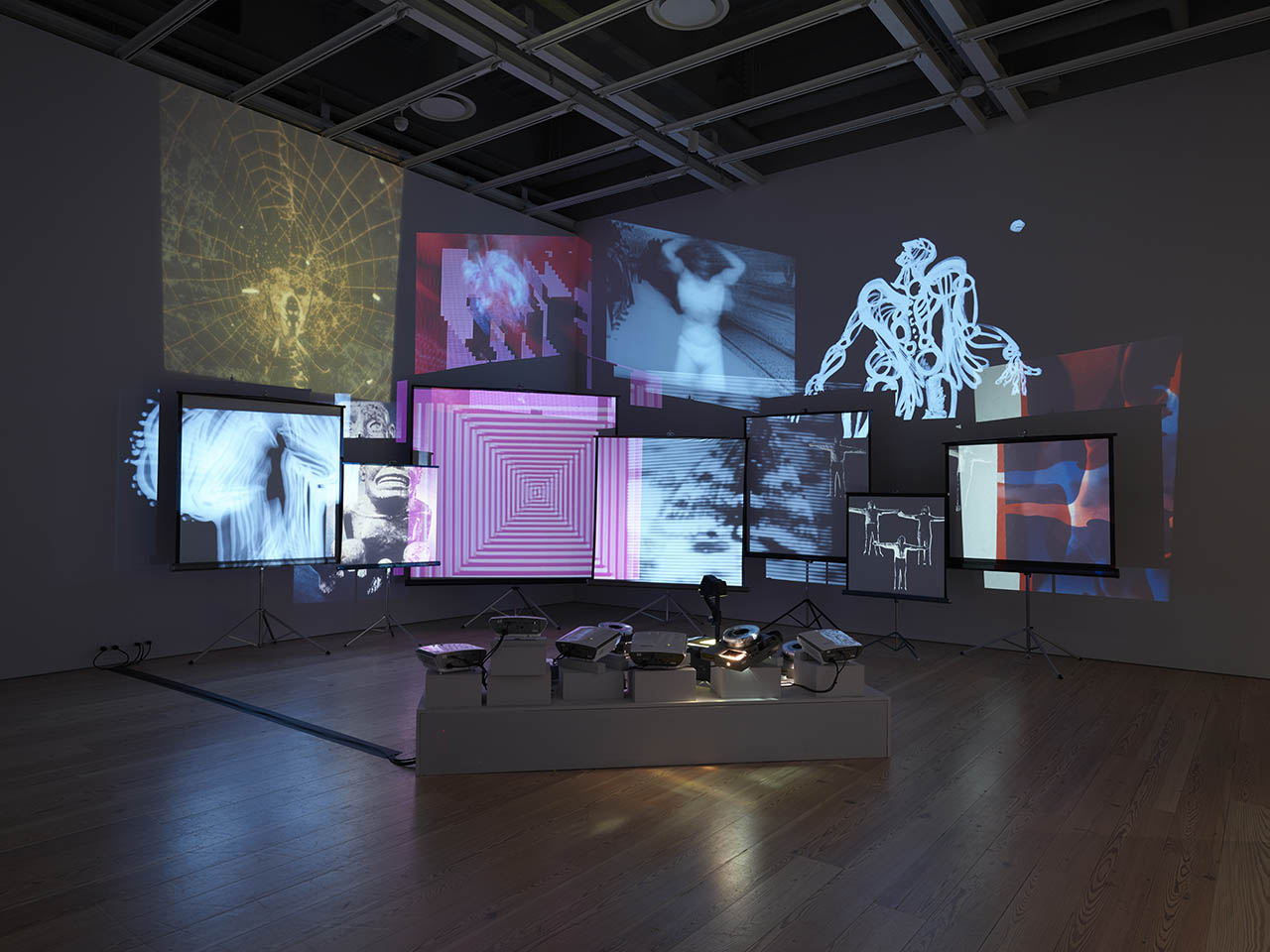
Launched in 2018 to address the needs of one of the largest time-based media art collections in the world, the Whitney’s Media Preservation Initiative (MPI) has reshaped the Museum’s understanding of its own collection and highlighted the need for a more comprehensive stewardship of time-based media (TBM) art. A holistic approach has been developed through sustained dialogue across several departments with the MPI team, whose inter-disciplinary specialists have re-catalogued, researched, and carried out preservation measures at the component level on 600 TBM artworks in just three years. In addition, through MPI the Whitney has pioneered a new system for preservation that equally foregrounds material, digital, and artistic integrity, scholarly research, and access. In this talk, Whitney staff will discuss their vision for the Museum’s TBM collection, while the MPI team recounts some of their greatest challenges and collaborative successes.
Hosted by the Time-based Media Art Conservation program at the Conservation Center, Institute of Fine Arts, NYU. Generously supported by the Andrew W. Mellon Foundation.
WMAA and MPI bios for webinar
Carol Mancusi-Ungaro serves as the Melva Bucksbaum Associate Director for Conservation and Research at the Whitney Museum of American Art and for over a decade as Founding Director of the Center for the Technical Study of Modern Art at the Harvard Art Museums. For nineteen years she served as Chief Conservator of The Menil Collection in Houston, Texas. During that time she founded the Artists Documentation Program wherein she interviews artists about the technical nature of their art (adp.menil.org).
Dr. Chrissie Iles is the Anne and Joel Ehrenkranz Curator at the Whitney Museum of American Art. Her curatorial focus is moving image art, the work of emerging artists, and art of the 1960s and 1970s. She builds the Whitney’s collection of film and video, and is part of the curatorial team that shapes the Museum’s artistic program. She is a member of the Graduate Committee of the Center of Curatorial Studies at Bard College, a Faculty member of the curatorial program at the School of Visual Arts, and a visiting critic in the Fine Art Department of Columbia University.
Farris Wahbeh, Director of Research Resources, works within the field of cultural informatics to enhance access to art and archival collections. He oversees the Frances Mulhall Achilles Library and maintains the Museum’s Special Collections and the Permanent Collection Documentation Office. Farris has gained experience from a wide range of institutions, including Columbia University’s Rare Book & Manuscript Library, the Getty Research Institute, the Provenance Index, the Creative Audio Archive in Chicago, Intuit: the Center for Intuitive and Outsider Art, as well as the King Abdullah University of Science and Technology (KAUST) and Saudi Aramco’s King Abdulazziz Center for World Culture
David Neary is the Project Manager of the Media Preservation Initiative. He is a graduate of NYU’s Moving Image Archiving and Preservation program and also holds an MA in Film Studies from University College Dublin. He has worked to preserve the film collections of institutions including Lincoln Center for the Performing Arts, MoMA, and the Oregon Historical Society.
Savannah Campbell is Media Preservation Specialist, Video and Digital Media at the Whitney Museum of American Art. She has previously been a Fellow in Magnetic Media Preservation at The Standby Program and has worked on audiovisual preservation projects for the Dance Heritage Coalition, CUNY TV, and Crawford Media Services. Savannah holds an MA in Moving Image Archiving and Preservation from New York University.
Brian Block has coordinated the Whitney’s effort to enhance its time-based media documentation practices in his role as Project Researcher. He created new templates for centralizing and analyzing TBM artworks and uses these tools when generating research data about the Museum’s TBM holdings. Brian is a 2018 graduate of UCLA, where he received a Master of Library & Information Science degree with a specialization in Media Archival Studies.
Christopher Bernu is the Project Cataloguer for MPI. He is a graduate of the University of Illinois at Chicago’s Museum and Exhibition Studies program. His previous experience includes projects for the Museum of Modern Art, the Art Institute of Chicago, the Museum of Contemporary Art Chicago, and the DuSable Museum of African American History.
Nicholas Carbone is the Media Preservation Specialist in film and slide works for the Media Preservation Initiative. In addition to his work there, he is also the Audiovisual Archivist for both the Trisha Brown Dance Company and the video artist Mary Lucier. In the past, Nicholas has worked on projects at the Carolee Schneemann Foundation, the Andy Warhol Film Project, Bard College and Artists Space.
Image caption: Stan VanDerBeek (1927-1984), Movie Mural, 1965-68. Multiple 35 and 16mm films, black-and-white and color, sound and silent, durations vary, transferred to video, with black-and-white and color slide projections. Whitney Museum of American Art, New York; purchase with funds from the Film and Video Committee. Photograph by Ron Amstutz. © Estate of Stan VanDerBeek
May 26, 2021
Speakers: J. Soto, Arts Administrator and Consultant, and Sally Szwed, Director of Artist Initiatives from Eyebeam
Title: Shifting online: Responsive transformations in art and technology
Join Sally Szwed and J. Soto from Eyebeam, an organization focused on supporting justice-driven artists working with technology, for a presentation and discussion on how the organization radically pivoted their support for artists, as well as public engagement strategies in both shape and scale at the onset of the Covid-19 crisis. Brought about by the conditions of 2020, these shifts provoke larger questions of the role of artists in the rapidly changing digital environment, sustainability, accessibility of digital spaces, and the possibilities when artists reclaim this type of technology in their work.
In this lecture the two will share some specific examples of inventive artist work that was produced in this formative moment, as well as strategies Eyebeam is undertaking to continue meaningful engagement with artists and the public as we continue to build community in the digital realm.
J. Soto is an arts administrator and consultant invested in the intersectional community histories and present of queer people of color and disabled people. Soto's work focuses on how to create more equitable practices and access to resources in the arts and dance field. His work and writing can be found in Original Plumbing, Apogee Journal: Queer History, Queer Now Folio, American Realness 2018 Reading series, and Jacob’s Pillow Dance Interactive, and Grant Makers in the Arts GIA Reader. His work is deeply influenced by his experiences as a queer transgender Latino who grew up in the Bay Area, with roots in Southern Arizona and the borderlands. He serves as the Manager of Programs and Inclusion at Eyebeam.
As Eyebeam’s Director of Artist Initiatives, Sally Szwed guides the organization's core artist support programs, youth education, and public engagement. Sally believes that artists are vital enactors of societal change, and are essential for inventing a radically equitable future. Sally is an accomplished arts leader in NYC. She previously directed the Creative Time Summit, an international convening on the intersection of art and politics. Sally grew the Summit in both scale and ambition, building an expansive global community while traveling iterations of the program to the 56th Venice Biennale and around the world. She holds an MA in Curatorial Practice from California College of the Arts.
April 21, 2021
Speaker: Hélia Marçal, Lecturer in History of Art, Materials and Technology at University College London
Title: Conservation Between Performance and Participation
Description: Conservation has long been recognized as a social activity, aimed at preserving objects and artworks as manifestations of values, affects, and stories. But how can conservators reconcile the values of past, present, and future generations, of local communities and global organisations, of the art institution and the public sphere? This presentation will look at conservation through the lens of performativity to address issues of representation, the politics of participation, and the social landscape in conservation. By exploring the challenges posed to conservation by performance and other forms of socially-engaged art, this lecture will reflect on how these types of artworks reframe conservation aims in the public sphere. Issues of representation and misrecognition in decision-making processes will be analysed through feminist epistemology – namely through Nancy Fraser's work. The presentation will then address the ways in which rethinking conservation through performance allows us to acknowledge the realms of difference and inclusion in our profession. Finally, the lecture will question and reflect on some of the ways in which we can bring new perspectives of compassionate care for artworks, objects, and people to the center of conservation practice.
Dr. Hélia Marçal is a lecturer, researcher, and conservator based in London. She was appointed Lecturer (Assistant Professor) in Art, Materials, and Technology at University College London's Department of History of Art in 2020. Prior to this appointment, she worked as a Fellow in Contemporary Art Conservation and Research of the Andrew W. Mellon funded research project "Reshaping the Collectible: When Artworks Live in the Museum at Tate and a Science Manager at the Institute of Contemporary History (Universidade Nova de Lisboa). She has been the Coordinator of the Working Group on Theory, History, and Ethics of Conservation of the International Council of Museums' Committee for Conservation since 2016.
This lecture series is generously funded by The Andrew W. Mellon Foundation.
December 2, 2020
Speaker: Pamela Z, Composer/Performer and Media Artist
Title: Sonic Gestures | Blurred Lines:
Working Across Disciplinary Boundaries and Through Shifting Technologies
Description: Through video and audio examples, composer/performer and interdisciplinary artist Pamela Z will share her work and process, and discuss the increasingly blurred lines between disciplines in her practice. Highlighting her use of voice, found objects, and sampled speech sounds, she will illustrate the various directions her work has taken over the years and address the effects of both rapid and gradual changes in technology have had on making, preserving, and documenting her work.
Pamela Z is a composer/performer and media artist making works for voice, electronic processing, samples, gesture activated MIDI controllers, and video. She has toured throughout the US, Europe, and Japan. Her work has been presented at venues and exhibitions including Bang on a Can (NY), the Japan Interlink Festival, Other Minds (SF), the Venice Biennale, and the Dakar Biennale. She has composed scores for dance, film, and chamber ensembles (including Kronos Quartet and Eighth Blackbird). Her awards include the Rome Prize, United States Artists, the Guggenheim, Doris Duke Artist Impact Award, Robert Rauschenberg Foundation, and the Herb Alpert Award.
This lecture series is generously funded by The Andrew W. Mellon Foundation.
November 11, 2020
Speaker: Tamiko Thiel, xR Mixed Reality Artist
Title: Archiving the Virtual: Conserving xR Mixed Reality Artworks
Description: Artworks with a substantial software component, whether the expressive blinking lights of an AI supercomputer or the algorithmic growth patterns of virtual "plastic garbage coral reefs," require upgrades and eventually migration to other platforms over the course of time periods that can range from several months to several decades (and hopefully longer). But what is important, what is the core of the artwork to be preserved, and what is an irrelevant technical artifact of a past time? Tamiko will talk about conserving and archiving her 35 year old supercomputer, her 20 year old virtual reality installation and 10 year of augmented reality artwork.
Bio: Tamiko Thiel has been exploring the interplay of place, space, the body and cultural identity in political and socially critical artworks for over 35 years. Her works in museum collections include: the Connection Machine CM2 (1987) A.I. supercomputer in MoMA NY; her virtual reality installation Beyond Manzanar (2000) in the San Jose Museum of Art in Silicon Valley; and her augmented reality installation Unexpected Growth (2018) in the collection of the Whitney Museum.In order to be able to conserve and archive not just Unexpected Growth, but also all the AR artworks she had made since 2010, she teamed up with her software developer husband Peter Graf to create the open source AR platform ARpoise, which they aim to keep alive irregardless of the commercial AR companies that come and go over the decades.
October 14, 2020
Speaker: Agathe Jarczyk, Associate Time-based Media Conservator at the Solomon R. Guggenheim Museum
"Mind the Gap. Building Institutional Knowledge in the Field of Time-based Media Conservation"
Description: The conservation of time-based media artworks often implies the involvement and expertise of external specialists. Conservators embrace and rely on their knowledge and experience. How can this external expert knowledge become institutional knowledge? Collecting and bundling information is one of the central tasks of conservators at institutions. What kind of documentation is required beyond the description of guidelines and processes? This talk reflects on the building of institutional knowledge and discusses how common tools and finding a common language support the museum's aims for collection care.
Agathe Jarczyk is the Associate Time-based Media Conservator at the Solomon R. Guggenheim Museum. Between 2011 and 2019 she was an adjunct professor at the Department of Conservation and Restoration at the University of the Arts in Bern, Switzerland. In 2008 she founded the Studio for Video Conservation and has been working for numerous Swiss and international museums and collections as conservator and consultant.
Topics in Time-based Media Art Conservation is supported by the Andrew W. Mellon Foundation.
Archive
November 13, 2019
Gloria Sutton, Associate Professor of Contemporary Art History at Northeastern University and a Research Affiliate in the Art Culture Technology Program at MIT
"Pattern Recognition: Contemporary Art in the Age of Digitality"
The title refers to the cognitive process by which newly acquired information is paired with historical knowledge to form a new understanding— in this case, how contemporary art itself has interpolated modernist image paradigms by critically adapting digital behaviors. Much of contemporary art can be understood through the following four concepts: 1. Interface instead of Medium; 2. Iteration over Originality, 3. Compositing rather than Assemblage and 4. Compression, not Abstraction. By offering a critique of the immersive, a term that has become a default descriptor for time based media often unmarked by the lived experiences of race, gender, class, and ability, not only shape and condition how people experience art, but also regulate and legislate their bodies in real time and real space. Ultimately, Pattern Recognition, outlines how digitality both reveals and occludes the mutual embeddedness of media and identity within contemporary art.
Gloria Sutton is Associate Professor of Contemporary Art History at Northeastern University and a Research Affiliate in the Art Culture Technology Program at MIT. Sutton’s book The Experience Machine: Stan VanDerBeek’s Movie-Drome and Expanded Cinema (MIT Press) was the first study of a signal member of the American avant garde whose experimental art works combined the logic of painting, film, video, photography, dance, television, computer programming and architecture to anticipate the current ways contemporary art operates under the pressure of digital networks. Sutton’s recent essays have centered on Hans Haacke and notions of animacy (New Museum); Elaine Summers and Intermedia (MoMA); Jennifer Bornstein’s monoprints (Radcliffe Institute for Advanced Study/ Sternberg Press); Simone Forti’s holograms (LACMA); Yayoi Kusama’s mirror rooms (Prestel/Hirshhorn). She is currently working on a monograph on the artist Shigeko Kubota (1937-2015).
September 18, 2019
Jonah Westerman
"Performance Art and the Problem of Medium- Definitions and Documentation in Practice"
Description: What do we expect from a performance’s documentation? How do we integrate performance art into a collection? What are we trying to find when we research a work’s past iterations and persistent forms, and what do we demonstrate when we curate, or translate, such objects out of the archive and into exhibitions? How should we conceive this production prospectively—what constitutes good documentation? If performance itself is notoriously difficult to wrangle as a category, the corollary question of how to understand and handle its associated artefacts (both material and otherwise) is no less daunting and no less necessary. For a long while, discussions about performance and its medium-identity have centered on questions of time. This talk will explore this temporal emphasis and offer alternate models for approaching the collection, conservation, and exhibition of performance.
April 3, 2019
Amy Whitaker, Assistant Professor, Art and Art Professions New York University, Steinhardt School
"Copy and Paste: The Work of Art in the Age of Digital Reproduction"
February 27, 2019
Martina Haidvogl, Associate Media Conservator, SFMOMA
"#TheTruth and Other Variabilities from SFMOMA’s Media Conservation Lab"
Abstract: The conceptual artwork #TheTruth (2013-ongoing) by Oakland-based artist Anthony Discenza embodies qualities that characterize many of today’s media artworks: variability of display, modification of source code, and a master composed of information. As custodians of such artworks, how can we best manage the change we’re already anticipating? How can we manage our own discomfort, evoked by a lack of clear boundaries of what the work can be and can become? Employing this artwork as a reference point, this talk explores the challenges institutions and collectors face when acquiring, exhibiting, and preserving media art, and presents one museum’s approach to collection care and stewardship. About the Speaker: Martina Haidvogl is the Associate Media Conservator at SFMOMA, where she has piloted documentation and preservation initiatives for the Media Arts collection since 2011. Martina has lectured and published internationally on media conservation and its implications for museum collections, as well as multi-voice documentation strategies using a MediaWiki platform. She studied conservation and restoration at the Academy of Fine Arts Vienna, Austria, and the Bern University of the Arts, Switzerland, majoring in conservation for modern and contemporary art. Before joining SFMOMA, she worked in a film lab, for the Austrian Filmmuseum, and for Agathe Jarczyk's Atelier fuer Videokonservierung in Bern.
November 29, 2018
Gabriel Barcia-Colombo
"Reality Augmented: Capturing and Archiving Memories through Digital Art"
Gabriel Barcia-Colombo, mixed media artist and Professor at the Interactive Telecommunications Program at New York University's Tisch School of the Arts.
October 18, 2018
"Programmed: Conserving Concepts"
Speakers include: Christiane Paul, Adjunct Curator of Digital Art, Whitney Museum of American Art
Carol Mancusi-Ungaro, Melva Bucksbaum Associate Director for Conservation and Research, Whitney Museum of American Art
May 20-22, 2018
It's About Time! Building a New Discipline: Time-Based Media Art Conservation
A Symposium hosted by The Institute of Fine Arts and Courant Institute of Mathematical Sciences, New York University
May 23, 2018
Take A Deep Breath: A Case Study of Authenticity in Installation Art
The Dedalus Foundation
The life of a conceptual artwork can incur many variations or alterations, from creation to each installation, cycles of storage and exhibition, travel, acquisition and beyond. When an institution acquires and exhibits a conceptual work, they take on the obligation to display the work as faithfully as possible. Research on Rafael Lozano-Hemmer's Last Breath (2012), revealed challenges specific to this work, and also inspires a broader discussion on authenticity and installation art. This presentation will explore the ethical limits of preserving authenticity in the exhibition of conceptual art and considerations of display. Lia Kramer will present her research followed by a conversation with Brian Castriota, Chrissie Iles, Julie Reiss, and Glenn Wharton to discuss the broader topic of preserving authenticity and what it means for conceptual art.
Panelists include: Lia Kramer, former Dedalus Fellow, Conservation of Modern and Contemporary Art, Institute of Fine Arts, NYU, Brian Castriota, Marie-Sklodowska-Curie ITN Research Fellow and Ph.D. Candidate, History of Art, University of Glasgow, Chrissie Iles, Anne and Joel Ehrenkranz Curator, Whitney Museum of American Art, Julie Reiss, Associate Professor and Program Director, Modern and Contemporary Art and the Market, Christie's Education, Glenn Wharton, Clinical Professor, Museum Studies, NYU.
Watch onlineBlog post by Joy Bloser
Wednesday April 5, 2017
Spotlight on New Talents in Time-Based Media Art Conservation
Dan Finn, "Time-based Media Conservation at the Smithsonian American Art Museum"
Brian Castriota, "Ontological Models and Authenticity in Time-Based Media Art Conservation"
The two “spotlights” are followed by a book presentation:
Hanna B. Hölling, "Paik’s Virtual Archive: Time, Change, and Materiality in Media Art"
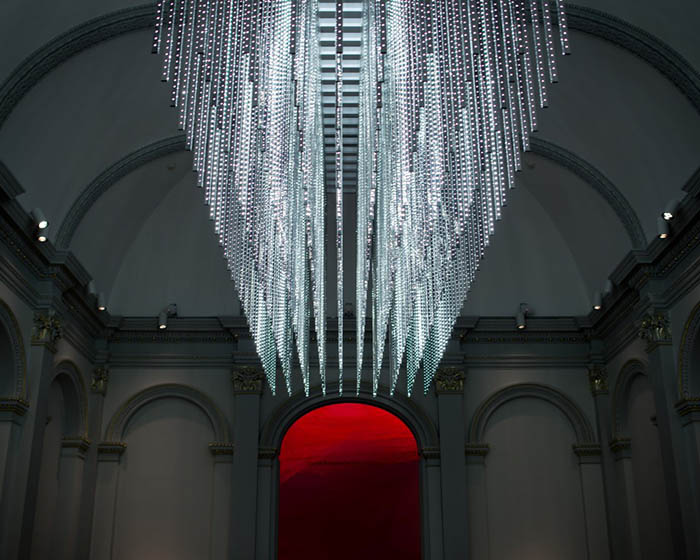
Leo Villareal. Volume (Renwick), 2015. Collection of Smithsonian American Art Museum, Gift of Janet and Jim Dicke, Tania and Tom Evans, Paula and Peter Lunder, and Debbie Petersen in honor of Elizabeth Broun. © Leo Villareal. |
Dan Finn: Time-based Media Conservation at the Smithsonian American Art Museum
Emergent conservators, preservationists, and archivists who concentrate in time-based media often find themselves in internships and post-graduate career opportunities where they are the first of their kind in their institutions. This is an advantageous situation to be in, but is always accompanied with numerous challenges both anticipated and unexpected. Dan will discuss his experience starting out as the Smithsonian American Art Museum’s first full-time conservator specializing in time-based media through the lens of the museum’s first major acquisition of a time-based media work after his arrival. Leo Villareal’s Volume (Renwick) is a large-scale software-based LED installation that poses many of the issues surrounding the examination, documentation, treatment, and exhibition of media art facing media conservation professionals.
About the speaker: Dan Finn is the Media Conservator at the Smithsonian American Art Museum, where he built the museum’s Media Conservation Lab and has refined conservation practices for time-based media art collections. He previously helped to establish the Media Archive of the Smithsonian National Museum of African American History and Culture, as well as document and perform migrations of analog media for Democracy Now!, the City University of New York Television Station, and the Academy of Motion Picture Arts and Sciences. He holds an MA from New York University’s Moving Image Archiving and Preservation Program.
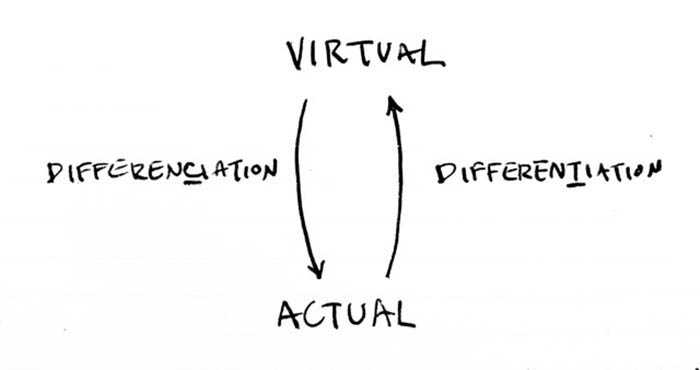
Schematic representation of Gilles Deleuze’s theory of "reciprocal determination” in Difference and Repetition (image by Brian Castriota). |
Brian Castriota: Ontological Models and Authenticity in Time-Based Media Art Conservation
Novel conservation approaches acknowledge that time-based media artworks can have multiple equally genuine instances despite there being differences or variation between them. Following on this observation, these approaches have sought ways to fix or tether works of art by discerning a work’s score or identifying a fixed set of properties or conditions through historical research and artist interviews. Many works of contemporary art have nevertheless proven resistant to such attempts at notation as material and contextual circumstances change, and statements made by the artist shift over time. As a consequence, what is regarded as essential to the work’s authentic persistence or occurrence may also be in flux.
In this lecture, Brian Castriota will introduce several ontological models from aesthetics and semiotics that he employs in his doctoral research to reframe the notion of authenticity in the case of variable and evolving works of modern and contemporary art. By considering a work of art as an instantiated, abstract object or type, this lecture will examine how questions of authenticity relate to the perception that a spatiotemporal object or event tokens or stands as a particular work. Castriota will explore how such a framework underlies conservation strategies for time-based media artworks, and how it may be used to consider questions of authenticity in the case of other objects of cultural heritage.
About the speaker: Brian Castriota is a time-based media art conservator based in Glasgow, Scotland. He earned an M.A. in History of Art and Archaeology and an Advanced Certificate in Conservation of Historic and Artistic Works from the Conservation Center of the Institute of Fine Arts at NYU where he graduated in 2014. He has since worked as a contract conservator for time-based media artworks at the Smithsonian American Art Museum, and was a Samuel H. Kress Fellow in time-based media conservation at the Solomon R. Guggenheim Museum in New York. He is currently pursuing a doctoral degree at the University of Glasgow within the research program "New Approaches in the Conservation of Contemporary Art" (NACCA) – a Marie Skłodowska-Curie Innovative Training Network – and he is also a Research Fellow in the Conservation of Contemporary Art at the Scottish National Gallery of Modern Art.
Book Presentation
Paik’s Virtual Archive: Time, Change, and Materiality in Media Art contemplates the identity of multimedia artworks by reconsidering the role of conservation in our understanding of what the artwork is and how it functions within and beyond a specific historical moment. In Hölling’s discussion of works by Nam June Paik (1932–2006), she explores the relation between the artworks’ concept and material, theories of musical performance and performativity, and the Bergsonian concept of duration. Ideas from art theory, philosophy, and aesthetics are used to probe questions related to materials and materiality of media art. Ultimately, she proposes that the archive is the foundation for the identity and continuity of every work of art.
//www.ucpress.edu/book.php?isbn=9780520288904
About the author: Hanna B. Hölling is Lecturer in the History of Art and Material Studies at the Department of History of Art, University College London. She was Andrew W. Mellon Visiting Professor, Cultures of Conservation, at the Bard Graduate Center in New York and received awards internationally. Among her many publications is Revisions—Zen for Film.
A video of this lecture was archived and is available in the Institute's video archive.
Wednesday, March 22, 2017
Spotlight on New Talents in Time-Based Media Art Conservation
with Amy Brost and Athena Christa Holbrook
Please note: This lecture takes place at the Michelson Theater, NYU Dept of Cinema Studies, 721 Broadway, 6th Floor, Room 648
September 19, 2016 @ MoMA
Pip Laurenson, Head of Collection Care Research, Tate, London, UK
Can Artworks Live in a Museums Collection?
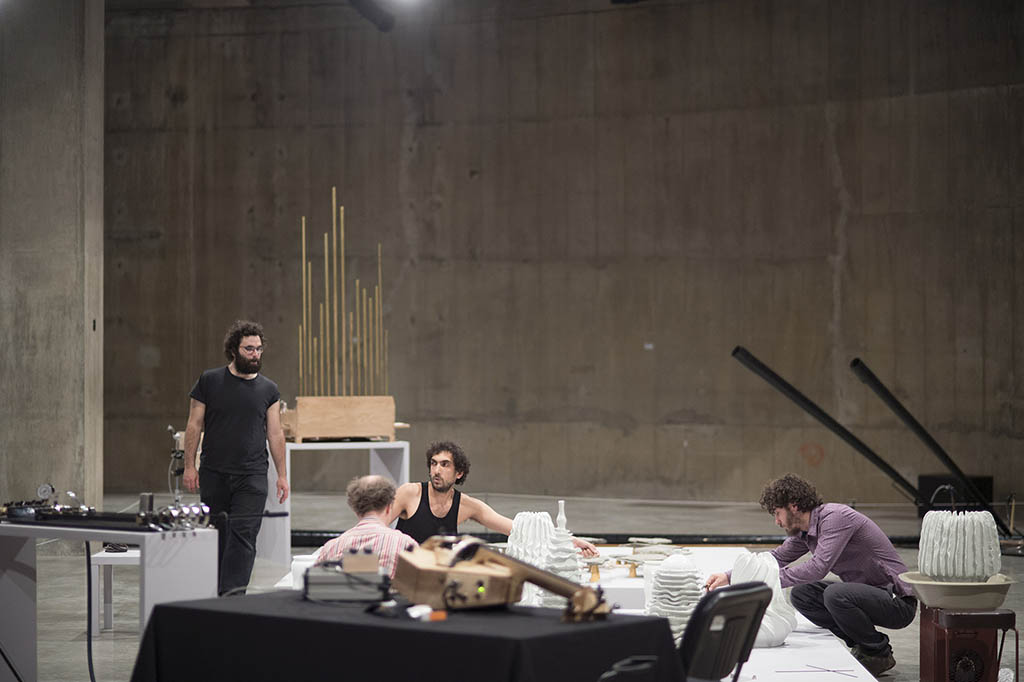
Tarek Atoui: The Reverse Collection, 2014, photograph taken during a performance in 2016; © Tate Photography |
Taking Hal Foster’s evocation of the idea of the zombie artwork as a starting point, this paper looks at the notion of the living and the dead in the conservation of time-based media. Drawing on case studies from Tate’s collection this paper will examine what is at stake for the artist, the conservator and the curator in these concepts and suggests a framework in which we can consider these different forms of engagement in relation to the unfolding ontologies of these works.
Pip Laurenson is the Head of Collection Care Research at Tate and Professor of Art Collection and Care at Maastricht University. She has over twenty years of experience in the conservation of contemporary art beginning her career in Sculpture Conservation and going on to establish and lead Tate’s pioneering Time-based Media Conservation section from 1996 until 2010. In her current role she develops, leads and supports research related to the conservation and management of Tate's collections. Pip is committed to interdisciplinary research that serves and responds to art of our time and in exploring what it means for a contemporary art museum to be a research organization. She received her PhD from University College London, is an accredited member of the Institute for Conservation, a trustee of the UK’s National Science and Heritage Forum, and is a member of the Steering Committee of the International Network for the Conservation of Contemporary Art (INCCA)
September 26, 2016
Reinhard Bek, Conservator of Contemporary Art - Bek & Frohnert LLC, New York
A Question of Kinethics
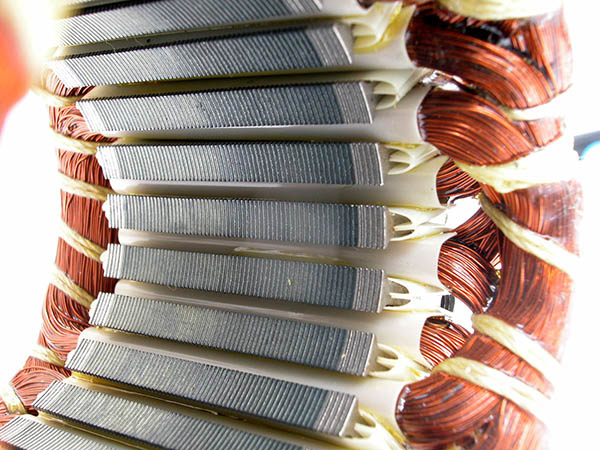
Detail of an electric motor © Reinhard Bek |
How do we incorporate artist intent into the preservation of kinetic works when such art is both performative and sculptural? Questions focused on artist intent tend to be handed over from artists to art professionals as these works age. Frequently, the initial preservation attempts impact future discussion around maintenance, replication and retirement. As a result, conservators of such works face a unique set of concerns that include evolving technology, the impact of art historical discourse, as well as the contexts in which such work is viewed. Case studies ranging from the modern to the contemporary will be discussed giving special voice to the artist's opinion.
Reinhard Bek apprenticed as a ship-builder in Hamburg from 1993 to 1996, prior to graduating as an objects conservator from the Conservation Program for Technical Cultural Objects of the HTW (Hochschule für Technik und Wirtschaft), University of Applied Sciences in Berlin, in 2002. Reinhard joined the Museum Tinguely in Basel, Switzerland, and was Chief Conservator from 2002 to 2012. He was a participant of the European Conservation Research projects INSIDE INSTALLATIONS and PRACTIC’S, 2003-2010. In 2009 he was a Conservation Research Fellow with The Museum of Modern Art in New York. Since 2012 Reinhard is partner of Bek & Frohnert LLC, based in New York City.
October 3, 2016
Rafael Lozano-Hemmer, Artist, Mexico-Canada
Best practices for conservation of media art from an Artist’s perspective
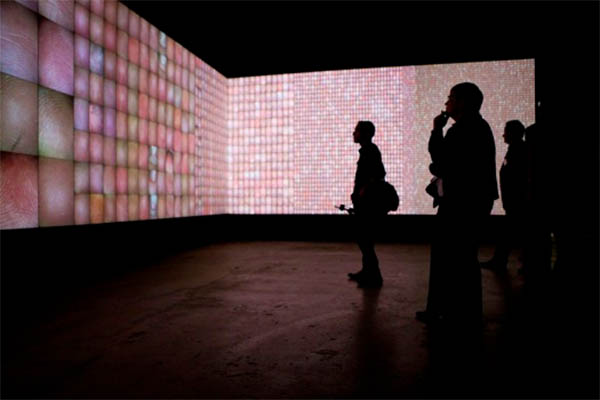
Rafael Lozano Hemmer, Pulse Index, 2010. Photo: Kate Russel |
For most artists I know “Art conservation” is a troubling affair: we are already too busy maintaining operations as it is, we think of our work as a “living” entity not as a fossil, we are often unsure if a project is finished, we snub techniques that may help us document, organize or account for our work as something that stifles our experimentation and creative process. In addition, there are many existing initiatives to preserve media artworks, but these are always from the perspective of the institutions that collect them. While most institutional programs include excellent artist-oriented components like interviews and questionnaires, the programs are all a posteriori, almost forensic, as they look at the work in retrospect, as a snapshot of time. This presentation will outline what artists may choose to do on the subject in order to i) simplify our life in the long run, ii) generate income, and iiii) take ownership of the way our work will be presented in the future.
Rafael Lozano-Hemmer is a Mexican-Canadian media artist that develops interactive installations that are at the intersection of architecture and performance art. His main interest is in creating platforms for public participation, by perverting technologies such as robotics, computerized surveillance, or telematic networks. Inspired by phantasmagoria, carnival, and animatronics, his light and shadow works are "antimonuments for alien agency.” Recently the subject of solo exhibitions at the MUAC Museum in Mexico City, the San Francisco Museum of Modern Art and the Museum of Contemporary Art in Sydney, he was the first artist to officially represent Mexico at the Venice Biennale with an exhibition at Palazzo Van Axel in 2007. He has also shown at Biennials in Havana, Istanbul, Kochi, Liverpool, Montréal, Moscow, New Orleans, Seoul, Seville, Shanghai, Singapore and Sydney. His work is in collections such as MoMA in New York, Hirshhorn in Washington DC, MUAC in Mexico and TATE in London. His large-scale public art installations have been commissioned for events such as the Millennium Celebrations in Mexico City (1999), the Cultural Capital of Europe in Rotterdam (2001), the UN World Summit of Cities in Lyon (2003), the Expansion of the European Union in Dublin (2004), the memorial for the Tlatelolco Student Massacre in Mexico City (2008), the Winter Olympics in Vancouver (2010) and the pre-opening exhibition for the Guggenheim Abu Dhabi (2015). Among his many awards are two BAFTAs from the British Academy, a Golden Nica at the Prix Ars Electronica in Austria, the Governor General’s Award in Canada, the Trophée des Lumières in France and an International Bauhaus Award in Germany. Website at www.lozano-hemmer.com
October 17, 2016
Christiane Paul, Associate Professor, School of Media Studies, The New School, New York; Adjunct Curator, New Media Arts, Whitney Museum of American Art, New York
Conserving Context: Approaches to Preserving Digital Art
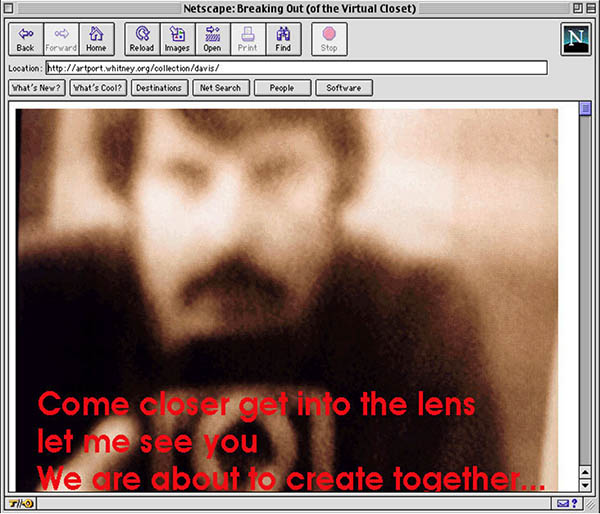
Douglas Davis, The World’s First Collaborative Sentence, 1994–, conserved 2012. Historic version: HTML and CGI script; live version: HTML and PHP script. Whitney Museum of American Art, New York. |
Digital art is engaged in a continuous struggle with an accelerating technological obsolescence that serves the profit-generating strategies of the tech industry. In addition, the way data is processed by digital technologies, particularly on the Internet, has required renegotiations of concepts such as the archive, content, and context. While the archiving of the historical and cultural context of art works is in itself not new, digital media and net art, in particular, pose new challenges for archiving in that they often incorporate or even consist of sources embedded in a larger contextual network — from simple links to third-party services or databases. The talk outlines the conceptual and practical challenges that digital art presents to institutions and the art market in terms of its archiving, contextualization, and preservation. Also discussed will be the frameworks of archives that can adapt to the changing requirements of the mutable digital "records" they contain; and the suitability of museums vs. other organizations in documenting and archiving different types of digital art.
Christiane Paul is Associate Professor at the School of Media Studies, The New School, and Adjunct Curator of New Media Arts at the Whitney Museum of American Art. She has written extensively on new media arts, lectured internationally on art and technology and is the recipient of the Thoma Foundation's 2016 Arts Writing Award in Digital Art. Her recent books are A Companion to Digital Art (Wiley Blackwell, 2016); Digital Art (Thames and Hudson, 3rd revised edition, 2015) Context Providers – Conditions of Meaning in Media Arts (Intellect, 2011; Chinese edition, 2012), co-edited with Margot Lovejoy and Victoria Vesna; and New Media in the White Cube and Beyond (UC Press, 2008). As Adjunct Curator of New Media Arts at the Whitney Museum of American Art, she curated several exhibitions—including Cory Arcangel: Pro Tools (2011), Profiling (2007), Data Dynamics (2001) and the net art selection for the 2002 Whitney Biennial—and is responsible for artport, the Whitney Museum’s website devoted to Internet art. Other recent curatorial work includes Little Sister (is watching you, too) (Pratt Manhattan Gallery, NYC, 2015); What Lies Beneath (Borusan Contemporary, Istanbul, 2015); The Public Private (Kellen Gallery, The New School, Feb. 7 - April 17, 2013), Eduardo Kac: Biotopes, Lagoglyphs and Transgenic Works (Rio de Janeiro, Brazil, 2010); Biennale Quadrilaterale (Rijeka, Croatia, 2009-10); Feedforward - The Angel of History (co-curated with Steve Dietz; Laboral Center for Art and Industrial Creation, Gijon, Spain, Oct. 2009); and INDAF Digital Art Festival (Incheon, Korea, Aug. 2009).
October 24, 2016
Tina Rivers Ryan, Curatorial Research Assistant, Modern and Contemporary Art, The Metropolitan Museum of Art, New York
Some More Beginnings: On the History of Time-Based Media Exhibitions
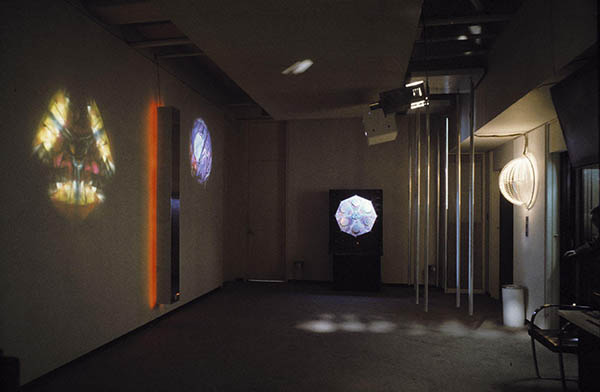
Installation view of the show "Lights in Orbit," Howard Wise Gallery, New York, 1967. |
Today, much of the discussion around the exhibition, collection, and conservation of "time-based media" focuses on natively digital works. However, the field of TBM is varied, including analog videotapes, celluloid films, kinetic sculptures, and a range of electronic machines. The history of these technologies extends back half a century or more, and so does the history of artists experimenting with media technologies, and exhibiting the results in galleries and museums. Given the increasing ubiquity of contemporary time-based media art, the research of these exhibitions and conservation of their objects has become more urgent. In this talk, Dr. Ryan will present a chronology of the most important early exhibitions of time-based media art, and consider the ways in which artists, curators, and conservators can learn from the past as they look to the future.
Dr. Tina Rivers Ryan is an art historian and critic specializing in modern and contemporary art, with an emphasis on new media art and technologies. Formerly an instructor at Columbia University, the Pratt Institute, and MoMA, she is currently a curatorial assistant at The Metropolitan Museum of Art, where she co-chairs the Time-Based Media Working Group. Her criticism has appeared in magazines such as Artforum and Art in America, and her scholarly work has been published in several edited anthologies and journals, including Art Journal and Framework: The Journal of Cinema and Media. She also has been commissioned to write on art and technology for the Walker Art Center, the Met, and the Tate. Her current book project, McLuhan's Bulbs: Light Art and the Dawn of New Media, examines the light art of the 1960s as a fulcrum between the discourses of “medium" and “media” in post-war art. Dr. Ryan received her BA from Harvard and PhD from Columbia.
November 7, 2016
Mona Jimenez, Associate Arts Professor/Associate Director; Moving Image Archiving and Preservation Program, New York University
Art in an Ecosystem: Media Art Communities & Conservation
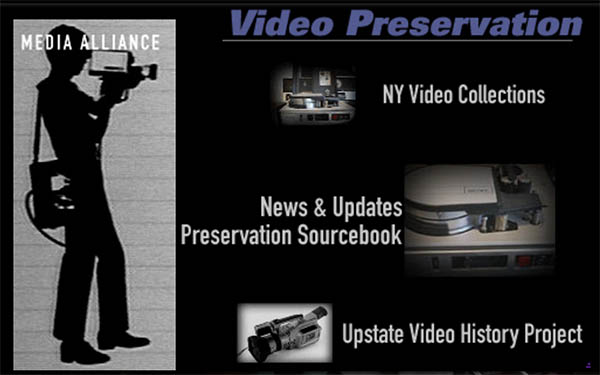
Image Caption: Screen capture from Media Alliance web site, 1999. See the Wayback Machine at https://web.archive.org/web/19990221222234///mediaalliance.org/vidpres.html |
The talk will address the role of media arts organizations, advocates and artists in the emergence of time-based media art conservation in the U.S. The speaker will suggest that creators, caretakers and other stakeholders are part of an ecosystem, with interconnections and interdependencies that bind us and can make us stronger, wiser and more effective.
Mona Jimenez learned to make video in 1974, and been an advocate and organizer for the preservation of independent media and media art since the 1980s when she first tried to transfer sticky tapes. She is Associate Arts Professor/ Associate Director in NYU’s Moving Image Archiving and Preservation Program, teaching the preservation of video and digital works. She experiments with participatory models of media/film archiving through Community Archiving Workshops, and founded Audiovisual Preservation Exchange (APEX), a project to create meaningful networks of audiovisual archivists, collection managers, educators and students internationally through shared work on collections. In recent years she led the establishment of a lab for disk imaging, emulation and analysis of early multimedia works, and helped plan the symposium TechFocus III: Caring for Software-based Art. With Sherry Miller Hocking and Kathy High, she co-edited The Emergence of Video Processing Tools: Television Becoming Unglued (Intellect Press, 2014), documenting collaborations between artists and technologists to create custom tools for electronic art.
November 14, 2016
Deena Engel, Clinical Professor; Associate Director of Undergraduate Studies for the computer Science Minors programs, Department of Computer Science, Courant Institute of Mathematical Sciences; New York University
Source Code Analysis in the Conservation of Software-based Art
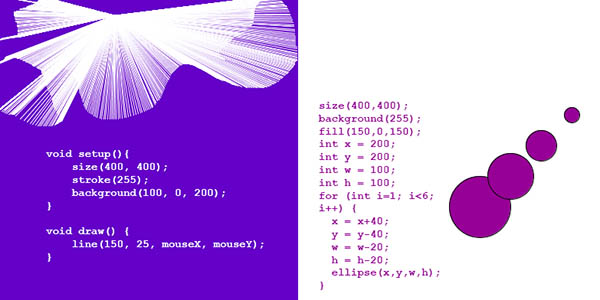
Code and Drawing, Image credit: Deena Engel |
How can source code analysis inform and support the conservation of software-based art? What is the cost in time and resources vs. the benefit to museums? Which skills are required for this task? What are the results? Can source code analysis directly benefit re-exhibition of software-based works of art? In this talk, Deena Engel will introduce concepts in software documentation as widely practiced in the IT field and show how this approach can be applied to software-based art. She will discuss the ways in which source code analysis can be applied to supplement traditional conservation documentation methodologies and practices. She will also contextualize the value of source code analysis within the larger framework of curatorial and conservation concerns by examining a variety of case studies from New York City collections to answer these questions and illustrate the discussion. There are no technical “pre-requisites” for this talk and questions will be welcome.
Deena Engel is a Clinical Professor as well as the Associate Director of Undergraduate Studies for the Computer Science Minors programs in the Department of Computer Science at the Courant Institute of Mathematical Sciences of New York University. She teaches undergraduate computer science courses on web and database technologies, as well as courses for undergraduate and graduate students in the Digital Humanities and the Arts. She also supervises undergraduate and graduate student research projects in the Digital Humanities and the Arts and collaborates on research on the conservation of software-based art. Prior to returning to academe, she ran a systems group in an international art auction house for nine years. She received her Master’s degree in Comparative Literature from SUNY-Binghamton and her Master’s degree in Computer Science from the Courant Institute of Mathematics at New York University.
November 21, 2016
Daniel Rozin, Associate Arts Professor, Interactive Telecommunications Program (ITP), NYU
and
Christine Frohnert , Conservator of Contemporary Art, Bek & Frohnert LLC, New York; Adjunct Professor & Time-Based Media Art Conservation Curriculum Development Program Coordinator, Conservation Center of The Institute of Fine Arts, New York University
Creating digital interactive kinetic sculptures for the long run - Daniel Rozin in conversation with Christine Frohnert
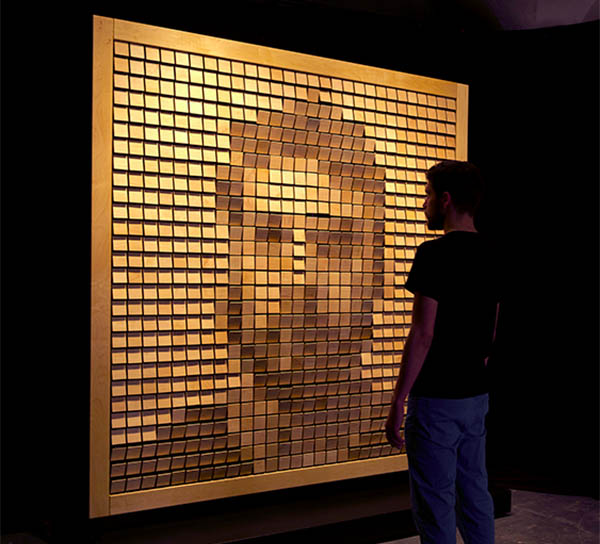
Daniel Rozin, Wooden Mirror, 2014; Wood, motors, video camera, custom software, microcontroller; 6 x 6 ft / 1.8 x 1.8 m |
This presentation addresses complex digital interactive artworks, including mechanical, electronic and digital systems, from an artist and educators point of view. Daniel Rozin will present case studies from his own practice with regard to the unique challenges in the course of creation and installation and will discuss this further in conversation with Christine Frohnert, sharing the approach of an artist with a conservator. Custom electronics, AV equipment and software packages are notorious for their inevitable obsolescence. Kinetic and mechanical systems are subject to failure and need for maintenance. Working in this particular intersection of tools and disciplines presents many opportunities and challenges for artists and conservators alike. Where can we draw from this experience to foresee new challenges in conservation on the long run?
Daniel Rozin is an artist, educator and developer, working in the area of interactive digital art. As an interactive artist Rozin creates installations and sculptures that have the unique ability to change and respond to the presence and point of view of the viewer. In many cases the viewer becomes the contents of the piece and in others the viewer is invited to take an active role in the creation of the piece. Even though computers are often used in Rozin's work, they are seldom visible. As an educator, Rozin is Associate Art Professor at the Interactive Telecommunications Program at Tisch School Of The Arts, NYU where he teaches such classes as: "The World- Pixel by Pixel", "Project Development Studio", "Toy Design Workshop", "Designing for Digital Fabrication" and "Kinetic Sculpture Workshop". Born in Jerusalem and trained as an industrial designer Rozin lives and works in New York. His work has been exhibited widely with solo exhibitions in the US and internationally and featured in many publications. His work has earned him numerous awards including Prix Ars Electronica, ID Design Review and the Chrysler Design Award.
Christine Frohnert is a conservator of contemporary art. She completed her training as paintings and sculpture conservator in Germany in 1993 and consequently joined the conservation department of the Museum Ludwig, Cologne. She held the position of the Chief Conservator from 2000-2005. She holds a diploma degree in the Conservation of Modern Materials and Media from the Conservation Program of the University of Arts, Berne, Switzerland (2003). She worked with Cranmer Art Conservation in New York City from 2005 until 2012. Ms. Frohnert was the chair (2008-2012) of the Electronic Media Group at the American Institute for Conservation and initiated the conference series 'TechFocus'. In May 2012 Christine Frohnert and Reinhard Bek founded Bek & Frohnert LLC, Conservation of Contemporary Art, providing consulting and conservation services with a focus on technology-based art. Christine Frohnert was named the inaugural Judith Praska Distinguished Visiting Professor teaching a seminar course at The Institute, entitled Art with a Plug – The Conservation of Artworks containing Motion, Sound, Light, Moving Images and Interactivity, Fall 2012. She is currently Time-based Media Art Conservation Curriculum Development Program Coordinator in the Time-based Media Art Conservation Curriculum Planning project team at The Institute of Fine Arts' Conservation Center.
November 28, 2016
Kate Lewis, Media Conservator; Peter Oleksik, Associate Media Conservator; Ben Fino-Radin, Associate Media Conservator at MoMA
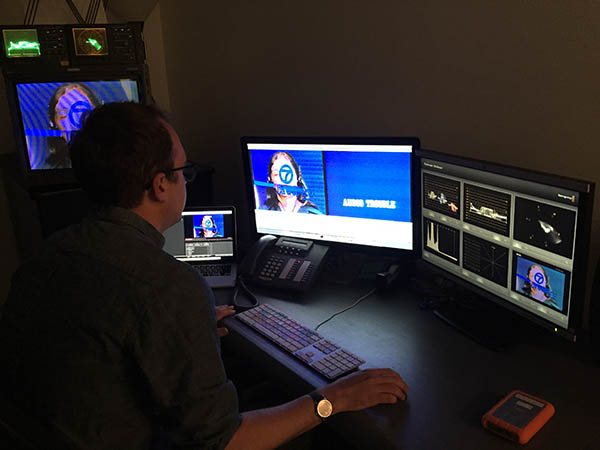
Peter Oleksik, condition checking "Boomerang" by Nancy Holt and Richard Serra (1974). Photo credit: Kate Lewis |
What is the day to day work of a museum media conservator? What does treatment entail? What philosophical questions do we debate? MoMA’s media conservation team will discuss their daily practice, and highlight approaches and challenges through various projects including two works currently on display at the museum: “Lovers” (1994) by Teiji Furuhashi and “The Ballad of Sexual Dependency” (1986) by Nan Goldin. Following the themes that underlie this lecture series, the speakers will introduce MoMA’s complimentary Media Conservation Initiative, a four year training focused project, funded by the Andrew W. Mellon Foundation.
Kate Lewis has been a Media Conservator at The Museum of Modern Art in New York since 2013. Prior to joining MoMA, from 2005 she was a Time-based Media Conservator at Tate. Lewis holds an M.A. in the Conservation of Works of Art from the University of Northumbria at Newcastle-upon-Tyne, and a B.A. in the History of Art from The Courtauld Institute of Art, University of London. She has served as Program Chair for the Electronic Media Group of the American Institute for Conservation of Historic and Artistic Works, on the planning committee for the TechFocus III workshop, is part of the Matters in Media Art initiative, and most recently joined the Program Committee for Voices in Contemporary Art.
Peter Oleksik is Associate Media Conservator at the Museum of Modern Art (MoMA) where he has been working since 2011 to conserve the museum's vast time-based media collection across curatorial departments. As a volunteer for the American Institute for Conservation's (AIC) Electronic Media Group (EMG), Oleksik has worked to make the post-print material accessible through a web resource. Peter is also a part of the Matters in Media Art (MMA) team, a collaboration between SFMOMA, The Tate and MoMA to provide resources on time-based media conservation. Additionally, Oleksik regularly works with independent artists, filmmakers and musicians to preserve and provide access to their media collections. Oleksik received his BA in Cinema Studies from the University of Southern California and his MA from New York University’s Moving Image Archiving and Preservation (MIAP) program where he is currently an adjunct professor.
Ben Fino-Radin has served as the Museum of Modern Art's Associate Media Conservator since 2013. In addition to specializing in the conservation of software based artworks, he has steered the design, development, and management of the open source software that comprises the museum's Digital Repository. Fino-Radin holds both an MS in Information Science, and an MFA in Digital Art from Pratt Institute. He sits on the steering committee of the Preservation and Archiving Special Interest Group, is a part of the Matters in Media Art initiative, and has served previously as Digital Conservator for Rhizome at the New Museum, and as an adjunct professor in NYU’s Moving Image Archiving and Preservation program, as well as maintaining a private consultancy.
December 5, 2016
Joanna Phillips, Senior Conservator, Time-based Media, Solomon R. Guggenheim Museum, New York
Implementing Time-based Media conservation in Museum Practice
This lecture will take place at the Metropolitan Museum of Art, Bonnie J. Sacerdote Lecture Hall— Ruth and Harold D. Uris Center for Education
Voices in Contemporary Art (VOCA) wrote about each of our Time-Based Media lectures.
read more on voca's blog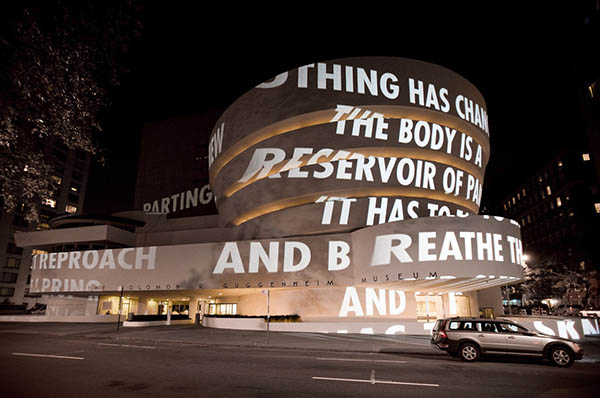
“For the Guggenheim” (2008) by Jenny Holzer, Light Projections, Solomon R. Guggenheim Museum, New York. Commissioned by the Solomon R. Guggenheim Foundation, in honor of Peter B. Lewis, 2008. Photo: Kristopher McKay |
This lecture discusses the implementation of time-based media conservation as a new collection care activity in museum practice, and as a new specialty within the professional discipline of fine arts conservation. Applied to video, audio, film, slide, software and performance artworks from the Guggenheim collection, a range of conservation approaches and activities are presented that have been developed and implemented at the Guggenheim in recent years. Topics addressed will cover the establishment of new conservation practices, the development of a new job profile, the navigation of institutional structures, the enhancement of collaborative workflows across departments, time-based media staffing and fundraising strategies, facilitation of collaborative research and development with partners inside and outside of the museum and integration of external specialist knowledge. A special focus is given to the skills sets required from conservation professionals who practice time-based media conservation.
Joanna Phillips is the Conservator of Time-based Media at the Solomon R. Guggenheim Museum in New York, where she founded the first media art conservation lab in an US museum. In her 8 years at the Guggenheim, Phillips has developed and implemented new strategies for the preservation, reinstallation, and documentation of time-based media works. Phillips publishes and lectures on this topic internationally. Her latest research initiative explores the conservation of software-based art. She is a founding co-organizer and multiple host of the conference series TechFocus. This year she co-organized the international symposium “Collecting and Conserving Performance Art” in Germany. Prior to her Guggenheim appointment, Phillips specialized in the conservation of contemporary art at the Swiss Institute for Art Research in Zürich and explored the challenges of media art conservation as a research conservator in the Swiss project “AktiveArchive". Phillips holds a master’s degree in paintings conservation from the Hochschule der Bildenden Künste in Dresden, Germany.
Please also note our activities related to curriculum development in Time-Based Media Art Conservation here.